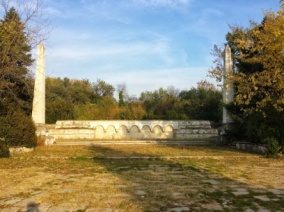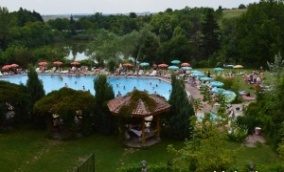

It is situated in the north – west corner of the village. It was built by the Romanian people, for immortalizing the memory of his courageous sons who died in the bloodiest battles during the times of the Liberation War from 1877 – 1878. In the proximity there are situated the historical redoubts Grivishko, in which there fell most of the Romanian militaries who fought besides the Russian army in the epical fights for the liberation of Pleven in 1877.
The mausoleum was built starting with 1892 until 1897 and its inauguration was made in 1902 on the occasion of the 25th celebration of the battles from Grivița – Pleven. It is built of white stone in a typical Renaissance style, combined with Roman – Byzantine elements. The shape is symmetrical cruciform. The high chapel ends with a metallic cross. Small metal crosses were placed on the principal cornice above the entrance and on the other opposite sides. Above the entrance it is present a stone adorned and opened arch. The mausoleum is formed from the premise of the temple and the charnel house from the basement. The walls and the chapel are entirely painted. The iconostasis and the mural paintings are the works of the Romanian artists. On the iconostasis from the left side it is placed a bronze medal in relief with a Romanian dedication – text for the courageous Romanian soldiers and the year “1902”, and on the right side – a bronze crown, donated by the Romanian teachers in 1904. On it there are inscribed the names of the inhabitants where there acted the Romanian Army during the times of the liberation war, “Pleven, Grivița, Nicopol, Vidin, Pute, Oryahovo”. The charnel house is practically re-built in 1966 – 1967; it is completely coated with white marble from Velingrad. Here, in the three bays in the floor, covered on the upper part, with floor tiles, decorated with marble crowns, there are kept the bones of the Romanian heroes who died in the battle from Grivița. In two lateral bays there are visible fighting scenes in relief: “Dorobanți in attack” – left and “the Conquest of the redoubt” – right. They are the works of the sculptor Georgi Gergov. On the left wall from the entrance, there are the words “They died gloriously in the battles from Pleven in 1877”, there are the names of the officers and the number of soldiers from different parts of the Romanian army, who fell for our freedom. In the mausoleum it is extended the spacious beautiful park of friendship. The construction started in 1958 with the efforts of the Bulgarian and of the Romanian masters. In the last years, the park is in a continuous expansion and arrangement. Forever green, the ornamental shrubs, the roses and the vegetation beautify this holy place for the appreciative generations. There are two large allays which lead to the central area of the park. Here it is built up: a monument of the warriors of Romanian origin, the common tomb with bronze relief of the Russian and of the Romanian heroes and at north there is the common monument tomb of the Russian soldiers who fell from the 19th Regiment Kostroma. Two white tall pillars of shivers and a vast playground are situated near the common tomb. At the western part from the principal alley of the park on the lawn there are three Russian towers. The Romanian mausoleum, the park of the Friendship and numerous monuments made of white stone will always remind of Grivița and of the great battles of liberation of the sons of the Russian people and of the Romanian people, who died in a fierce battle with the secular enemy.




